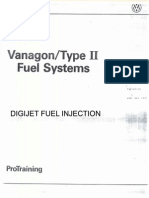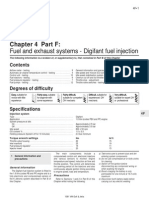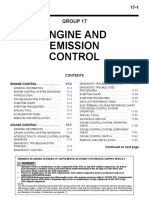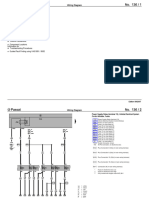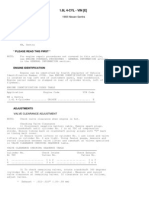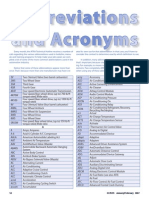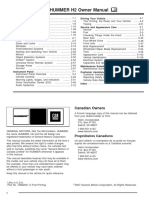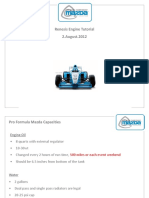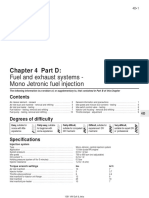Digijet
Digijet
Uploaded by
Valentina Mains D'orCopyright:
Available Formats
Digijet
Digijet
Uploaded by
Valentina Mains D'orOriginal Title
Copyright
Available Formats
Share this document
Did you find this document useful?
Is this content inappropriate?
Copyright:
Available Formats
Digijet
Digijet
Uploaded by
Valentina Mains D'orCopyright:
Available Formats
4E1
Chapter 4 Part E: Fuel and exhaust systems - Digijet fuel injection
Contents
Air cleaner element - renewal . . . . . . . . . . . . . . . . . . . . . . . . . . . . . . 2 Airflow meter - testing . . . . . . . . . . . . . . . . . . . . . . . . . . . . . . . . . . . . 4 Evaporative fuel control system . . . . . . . . . . . . . . . . . . . . . . . . . . . . 10 Fuel injectors - testing . . . . . . . . . . . . . . . . . . . . . . . . . . . . . . . . . . . . 6 General information and precautions . . . . . . . . . . . . . . . . . . . . . . . . 1 Idle speed and mixture - adjustment . . . . . . . . . . . . . . . . . . . . . . . . . Inlet air pre-heater - testing . . . . . . . . . . . . . . . . . . . . . . . . . . . . . . . . Pre-throttle valve clearance - adjustment . . . . . . . . . . . . . . . . . . . . . System components - removal and refitting . . . . . . . . . . . . . . . . . . . Throttle valve switch - testing . . . . . . . . . . . . . . . . . . . . . . . . . . . . . . 3 5 8 9 7
Degrees of difficulty
Easy, suitable for novice with little experience
4E
Fairly easy, suitable for beginner with some experience
Fairly difficult, suitable for competent DIY mechanic
Difficult, suitable for experienced DIY mechanic
Very difficult, suitable for expert DIY or professional
Specifications
Injection system
Type . . . . . . . . . . . . . . . . . . . . . . . . . . . . . . . . . . . . . . . . . . . . . . . . . . . . Application . . . . . . . . . . . . . . . . . . . . . . . . . . . . . . . . . . . . . . . . . . . . . . . Control unit code colour: Up to July 1989 . . . . . . . . . . . . . . . . . . . . . . . . . . . . . . . . . . . . . . . . . . From July 1989 . . . . . . . . . . . . . . . . . . . . . . . . . . . . . . . . . . . . . . . . . . System pressure (approx): Vacuum hose connected . . . . . . . . . . . . . . . . . . . . . . . . . . . . . . . . . . Vacuum hose disconnected . . . . . . . . . . . . . . . . . . . . . . . . . . . . . . . . Idle speed: Up to July 1989 . . . . . . . . . . . . . . . . . . . . . . . . . . . . . . . . . . . . . . . . . . July 1989 . . . . . . . . . . . . . . . . . . . . . . . . . . . . . . . . . . . . . . . . . . . . . . . Speed limiter . . . . . . . . . . . . . . . . . . . . . . . . . . . . . . . . . . . . . . . . . . . . . . CO content %: Up to July 1989 . . . . . . . . . . . . . . . . . . . . . . . . . . . . . . . . . . . . . . . . . . July 1989 . . . . . . . . . . . . . . . . . . . . . . . . . . . . . . . . . . . . . . . . . . . . . . . Injectors: Resistance . . . . . . . . . . . . . . . . . . . . . . . . . . . . . . . . . . . . . . . . . . . . . Spray pattern . . . . . . . . . . . . . . . . . . . . . . . . . . . . . . . . . . . . . . . . . . . Digijet 1.3 litre (code NZ) engine Copper-brown sticker Blue sticker 2.5 bar 3.0 bar 750 to 850 rpm 880 to 980 rpm 6400 to 6500 rpm 0.3 to 0.11 0.3 to 1.5 15 to 20 ohms Conical
1081 VW Golf & Jetta
4E2 Fuel and exhaust systems - Digijet fuel injection
1 General information and precautions General information
The Digijet fuel injection system is fitted to the 1.3 litre (code NZ) engine (see illustrations). The system is regulated in accordance with instructions received from a control unit, located in the bulkhead plenum chamber on the left-hand side. This unit was modified in July of 1989 and can be identified by a blue sticker on the unit, earlier units having a copper-brown sticker. The fuel pump and its location is identical to that described in Part F of this Chapter for the Digifant fuel injection system. The fuel tank and its associated components are identical to those shown in Part A of this Chapter, the only difference being the feed line attachment to the gravity valve from the charcoal filter.
1.0a Digijet fuel injection system component location 1 2 3 4 5 6 7 8 9 10 11 12 Airflow meter Fuel pressure regulator Heater element Injector Throttle valve housing Idle speed adjustment screw Throttle valve switch Auxiliary air valve connector Lambda probe connector Intake air preheating vacuum unit Digijet control unit/TCI-H switch unit Air cleaner 13 14 15 16 17 18 Cut-off valve Mixture (CO) adjustment screw Spark plug Auxiliary air valve CO measuring pipe Temperature sender (blue) for Digijet system 19 Temperature sender (black) for coolant temperature gauge 20 Distributor (with Hall sender) 21 Ignition coil
Precautions
Refer to Sections 1 and 2 in Part B of this Chapter.
2 Air cleaner element - renewal
Refer to Chapter 1, Section 32
1.0b Digijet fuel injection system components 1 2 3 4 5 6 7 8 9 10 11 Air intake elbow Lambda probe connector Bolt Fuel pressure measuring connector O-ring Fuel pressure regulator Fuel return pipe (blue) Fuel supply pipe (black) Gasket Intake manifold Connector 12 13 14 15 16 17 18 19 20 21 Control unit Lambda probe Clip Injector manifold Connector Injector Temperature sender (blue) Clip Throttle valve housing To air cleaner lower port regulating flap
1081 VW Golf & Jetta
Fuel and exhaust systems - Digijet fuel injection 4E3
5 Inlet air pre-heater - testing
3.4 CO analyser and connecting pipe
3.7 Idle speed (A) and mixture adjustment (B) screws c) The ignition timing adjustment must be correct 3 Pull free the crankcase ventilation hose from the pressure regulating valve and plug it. 4 With the ignition switched off, connect a tachometer in accordance with the manufacturers instructions, then connect the CO analyser to the measuring pipe (see illustration). An adapter will probably be needed to ensure a good seal between the analyser hose and measuring pipe. 5 Disconnect the Lambda probe wiring plug from its in-line connector. 6 Start the engine and check that the idle speed and CO content are as specified. If the idle speed is too high, check that the throttle valve is fully closing before making any adjustments to the idle speed. 7 If adjustment to the idle speed and/or the mixture (CO content) is required, turn the appropriate adjuster screw as necessary (see illustration). 8 If the CO content is to be adjusted, the mixture screws tamperproof cap will have to be carefully prised free and a suitable Allen key used to make the adjustment. On models produced from July 1989 on, the idle speed should initially be between 900 to 1000 rpm and the CO content between 1.0 and 1.4%. When the Lambda probe is reconnected, the idle speed and the CO content should settle down to the specified setting. Fit a new tamperproof cap over the mixture screw on completion. 9 With the idle speed/CO content correct, disconnect the analyser and reconnect the Lambda probe wiring plug.
3 Idle speed and mixture adjustment
1 The inlet air pre-heater is fitted to engines manufactured from September 1989. 2 A hot air blower such as a hair dryer can be used to test the pre-heater. First release the retaining clips, lift the lid from the air cleaner unit and remove the element - see illustration, Section 32, Chapter 1. 3 With the engine cold and with the air temperature around the pre-heater between 5 to 15 C, the warm air flap valve must be seen to be open. On heating up the air temperature in the area of the air inlet valve to over 20C, the valve should be seen to close.
1 The idle speed can only be accurately checked using a suitable tachometer and an exhaust CO analyser. VW recommend that the inlet air temperature sender in the airflow meter must ideally be set to 1.8 K ohms to provide a neutral air inlet temperature. As this requires the use of specialised VW equipment, an approximate check/setting will therefore have to suffice. 2 When checking or making any adjustments to the idle speed, it is important to adhere to the following: a) The engine must be at its normal operating temperature b) All electrical components must be switched off, including the cooling fan
6 Fuel injectors - testing
Refer to Section 13 in Part B of this Chapter and proceed as described. Note however that the dribble test in paragraph 5 differs. Switch on the ignition for a period of 5 seconds and check that no more than 2 drips per minute leak from any of the injectors.
7 Throttle valve switch - testing
2
4E
4.1a Control unit plug showing terminal connectors
1 A multi-meter (set to the resistance scale) will be required to make this test. 2 Pull free the wiring connector from the throttle valve switch, connect up the meter probes between the switch contacts and check that the reading is zero ohms (see illustration). Operate the throttle to fully open it (a high infinite resistance reading will be shown on the meter), then slowly close the throttle to the point where 0.3 mm clearance exists between the throttle lever and the stop screw. Check that zero ohms is shown on the meter.
4 Airflow meter - testing
4.1b Intake air temperature sender resistance graph
The efficiency of the airflow meter in the inlet manifold is checked by measuring the resistance value between contacts 1 and 4 of the control unit plug (see illustrations). The potentiometer is measured in the same manner by connecting the probes to terminals 2 and 3 and simultaneously operating the airflow sensor plate. The resistance reading must be seen to fluctuate.
7.2 Throttle valve switch test meter connections and securing screws
1081 VW Golf & Jetta
4E4 Fuel and exhaust systems - Digijet fuel injection
7.3 Feeler blade location for throttle valve switch check
7.5 Throttle valve basic setting showing limiting screw (A) and stop (B)
8.2 Measuring pre-throttle valve clearance using 0.5 mm twist drill Adjustment screw and locknut also indicated
3 Insert a feeler blade of 0.3 mm thickness between the lever and the stop screw to ensure the correct clearance (see illustration). If adjustment is required, loosen off the throttle valve switch screws then move the switch in the required direction to the point where the zero ohms reading is shown. Retighten the screws. Fully open the throttle valve and check that it is switched on as described above. Reconnect the wiring connector to the switch on completion of the check. 4 It should be noted that the throttle valve basic setting is made during production and in normal circumstances, it should not require further adjustment. 5 If minor adjustment to the valve setting is
necessary, it can be made by loosening off the limiting screw to provide a minimal clearance between the screw and the stop, then tightening the screw until it just comes into contact with the stop (see illustration). This setting is critical and to judge when the contact point is made, a piece of thin paper should be positioned between the lever and stop screw. Move the paper and simultaneously tighten the screw to the point where the paper is just clamped by the screw. From this point, tighten the screw a further half turn. 6 If adjustment has been made, the idle speed and mixture should be checked, as should the throttle valve switch. 9.1a Vacuum hose identification
8 Pre-throttle valve clearance - adjustment
The pre-throttle valve clearance is set during production and under normal circumstances should not require checking and adjustment. If the clearance is to be checked, first remove the air cleaner unit. Using a suitable 0.5 mm diameter twist drill, check the clearance at the point indicated (see illustration). If adjustment is required, loosen off the locknut and turn the adjuster screw in the required direction to set the clearance, then retighten the locknut.
1 To activated charcoal filter 2 Cut-off valve 3 Auxiliary air valve/inlet manifold hose 4 Intake elbow
5 Ignition distributor 6 Fuel pressure regulator 7 Air cleaner 8 Throttle valve housing 9 Connector (3-way)
9 System components removal and refitting
By reference to the illustrations accompanying this Chapter, removal and refitting of the various components of the system are self explanatory. However, the following special points should be noted: a) Observe the precautions described in Sections 1 and 2, Part B of this Chapter, whenever any parts of the system are to be removed and refitted. b) To ensure correct reassembly, ensure that the routings and connections of the system wiring, fuel and vacuum components are noted prior to disconnection (see illustrations). c) If the injector manifold is to be removed, it is first necessary to detach and remove the air inlet elbow complete with the throttle valve housing. d) Any component O-rings and gaskets must be renewed. e) The accelerator cable removal, refitting and adjustment procedures are as described in Part A of this Chapter. f) The fuel tank and its associated components are removed in a similar manner to that described in Part A of this Chapter, the only difference being the
1081 VW Golf & Jetta
Fuel and exhaust systems - Digijet fuel injection 4E5
feed line attachment to the gravity valve from the charcoal filter. g) The fuel pump and its location is identical to that described in Part F of this Chapter. recirculating the fuel vapours in the fuel tank to prevent them from escaping to the atmosphere (see illustration). 2 When the engine is stopped or idling, fuel vapour is collected by the charcoal canister where it is stored until the engine is started and run above idle speed. The vapour is then transferred from the canister, through a cut-off valve, into the air filter and inlet manifold to be burnt off during the normal combustion process. 3 The charcoal canister is secured to the base of the air cleaner unit and access to it for inspection or renewal is possible after first removing the air cleaner.
10 Evaporative fuel control system
1 The function of this system is to aid evaporative fuel control by collecting and
10.1 Activated charcoal filter system components A Fuel tank vapour route when engine is idling or stopped B/C Fuel tank vapour route when engine is run above idle speed 1 Pipe (to fuel tank gravity valve in filler line) 2 Cut-off valve 3 4 5 6 7 Fixing screw Activated charcoal canister Throttle valve housing Hose (auxiliary air valve/inlet manifold) Hose (to ignition distributor)
4E
9.1b Air intake manifold and associated components 1 2 3 4 5 6 7 8 9 10 11 12 13 Intake hose Clip Elbow Hose to regulating flap Gasket Idle speed adjusting screw O-ring Connector Throttle valve switch Angled connector Throttle valve housing Screw Gasket 14 Brake servo vacuum connection 15 Bolt 16 Intake manifold 17 Auxiliary air valve 18 Bolt 19 Bracket 20 Vacuum hose (to ignition distributor) 21 Vacuum hose (to non-return valve) 22 Fast idle cam 23 Fuel pressure regulator hose
1081 VW Golf & Jetta
4E6
Notes
1081 VW Golf & Jetta
You might also like
- Bosch Me 7.4.6Document23 pagesBosch Me 7.4.6ahmad adelNo ratings yet
- Elsa Online. ElsaWin. ElsaWeb. VWDocument3 pagesElsa Online. ElsaWin. ElsaWeb. VWAndrei Ionut UtaNo ratings yet
- Bosch Vp37 PumpsDocument32 pagesBosch Vp37 PumpsLuís Fidalgo93% (14)
- Digijet FI 2 User ManualDocument50 pagesDigijet FI 2 User ManualLewis LackNo ratings yet
- Print-11 07 2023-185618Document8 pagesPrint-11 07 2023-185618Radu CiubanNo ratings yet
- S3 Diagram of Coolant Hose Connections PDFDocument2 pagesS3 Diagram of Coolant Hose Connections PDFAlex100% (1)
- General Information - Primera P11-144Document54 pagesGeneral Information - Primera P11-144Ishmael Wooloo0% (1)
- Service and Maintenance PDFDocument19 pagesService and Maintenance PDFMyakoNo ratings yet
- DOHC ZC Parts ListDocument6 pagesDOHC ZC Parts ListcuentaNETNo ratings yet
- 2017 Infiniti QX30 TextDocument157 pages2017 Infiniti QX30 Textjamarcusbrown123No ratings yet
- Construction N45 ENT 125 KW (170 HP) at 2200 RPMDocument2 pagesConstruction N45 ENT 125 KW (170 HP) at 2200 RPMJasmin SelimićNo ratings yet
- DigifantDocument6 pagesDigifantembokoNo ratings yet
- L Jetronic BMWDocument38 pagesL Jetronic BMWcasecaseinter7No ratings yet
- Engine and Emission Control: Group 17Document78 pagesEngine and Emission Control: Group 17Toponari Medve100% (1)
- Niva TbiDocument11 pagesNiva Tbimicki3No ratings yet
- Engine Compartment : Connector SymbolDocument11 pagesEngine Compartment : Connector Symbolskulikov191974No ratings yet
- Volkswagen - New Beetle - Wiring Diagram - 2007 - 2008Document13,861 pagesVolkswagen - New Beetle - Wiring Diagram - 2007 - 2008Harshad NaringrekarNo ratings yet
- Comfort System: Wiring DiagramDocument22 pagesComfort System: Wiring DiagramHernán NuñezNo ratings yet
- BOR Hemi Installation GuideDocument43 pagesBOR Hemi Installation GuideBryan100% (2)
- Nissan X Trail Idle Air Volume Relearn Procedure1Document10 pagesNissan X Trail Idle Air Volume Relearn Procedure1Mohammed Kamel0% (1)
- Daewoo Matiz - Hydraulic BrakesDocument14 pagesDaewoo Matiz - Hydraulic BrakesadrianNo ratings yet
- SEW EURODRIVE Wiring Diagrams (New)Document30 pagesSEW EURODRIVE Wiring Diagrams (New)Simon Tolomeo100% (1)
- Megasquirt-3 Setting Up MS3 1.3.xDocument156 pagesMegasquirt-3 Setting Up MS3 1.3.xSergio BurdínNo ratings yet
- 420A Part ListDocument2 pages420A Part ListSergio CalderonNo ratings yet
- Super Airflow Converter: Super Air Flow Converter Wiring Diagram by ModelDocument64 pagesSuper Airflow Converter: Super Air Flow Converter Wiring Diagram by ModelOdien SalehNo ratings yet
- Current Flow Diagram: Airbags and Belt Tensioners For Driver and Front PassengerDocument3 pagesCurrent Flow Diagram: Airbags and Belt Tensioners For Driver and Front PassengerRoberto BlazquezNo ratings yet
- Tempmatic Climate ControlDocument144 pagesTempmatic Climate ControlGreg HannaNo ratings yet
- MTX-L PlusDocument14 pagesMTX-L Plusjuanlasserre9444No ratings yet
- 1.6l 4 CylDocument29 pages1.6l 4 Cyl25912530100% (1)
- The Complete BEAMS 3S GE Wiring Guide v3.0Document45 pagesThe Complete BEAMS 3S GE Wiring Guide v3.0lucassanabria2No ratings yet
- GR00000300-90 EvoDocument392 pagesGR00000300-90 Evodwi20100% (2)
- Abbreviations AutodataDocument10 pagesAbbreviations AutodataAORA BUILDINGNo ratings yet
- Speedster ManualDocument177 pagesSpeedster Manualabrakadabra111No ratings yet
- Kia Truck Sportage 2wd 2dr l4-2.0l - Timing Belt Removal and InstallationDocument11 pagesKia Truck Sportage 2wd 2dr l4-2.0l - Timing Belt Removal and Installationthanhtam3819No ratings yet
- AcrónimosDocument40 pagesAcrónimosAngel Corro LemmNo ratings yet
- Familia 33 BQ 50Document76 pagesFamilia 33 BQ 50FlakoO0No ratings yet
- Sti Wiring Sys PDFDocument148 pagesSti Wiring Sys PDFEdwinNo ratings yet
- Stag 400 Dpi ManualDocument44 pagesStag 400 Dpi ManualchkzaNo ratings yet
- Power MirrorsDocument9 pagesPower Mirrorsred eagle winsNo ratings yet
- DTC U1000 Can Communication LineDocument37 pagesDTC U1000 Can Communication LineCristiam QuispeNo ratings yet
- Instrument Panel Analog - Nissan Sentra 1993Document8 pagesInstrument Panel Analog - Nissan Sentra 1993Alessandro BaffaNo ratings yet
- Motor Daewoo Lanos Mecanica ElectricidadDocument615 pagesMotor Daewoo Lanos Mecanica Electricidadenriqu33sNo ratings yet
- ToyotaDocument12 pagesToyotaZarate CruzNo ratings yet
- Libro Motores VW Volkswagen Datos HaynesDocument127 pagesLibro Motores VW Volkswagen Datos HaynesCésar Santos100% (1)
- Fuel System PDFDocument210 pagesFuel System PDFpintuNo ratings yet
- ARP Head and Main Stud DetailsDocument14 pagesARP Head and Main Stud DetailsharleyjohnssonNo ratings yet
- 2008 Hummer h2 OwnersDocument504 pages2008 Hummer h2 OwnersBoris GasevicNo ratings yet
- Diagnostic Trouble Code ChartDocument5 pagesDiagnostic Trouble Code ChartGregory AshleyNo ratings yet
- Presentation On Power Steering: Yogeesh Sharma 1282, 7MAE - 2Document30 pagesPresentation On Power Steering: Yogeesh Sharma 1282, 7MAE - 2deepal123ab100% (1)
- Captiva 2008 Out Speed Sensor ReemplacementDocument3 pagesCaptiva 2008 Out Speed Sensor ReemplacementJose Luis Velasquez RomeroNo ratings yet
- Sony CD Player CDX-GT45U PDFDocument52 pagesSony CD Player CDX-GT45U PDFCedNo ratings yet
- Installation Instructions For 30-1910: Fuel Ignition Controller (F/IC)Document24 pagesInstallation Instructions For 30-1910: Fuel Ignition Controller (F/IC)Dmentall IllNo ratings yet
- Star MazdaDocument40 pagesStar MazdastvnscottNo ratings yet
- HFC Hydrogen Fuel Cell Cars: The Next Generation in Electric CarsFrom EverandHFC Hydrogen Fuel Cell Cars: The Next Generation in Electric CarsNo ratings yet
- Sistema de Inyeccion Mono-JetronicDocument6 pagesSistema de Inyeccion Mono-JetronicDiego De La FuenteNo ratings yet
- Chapter 4 Part C:: Fuel and Exhaust Systems - K-Jetronic Fuel Injection - 16 Valve EnginesDocument6 pagesChapter 4 Part C:: Fuel and Exhaust Systems - K-Jetronic Fuel Injection - 16 Valve EnginesmohhizbarNo ratings yet
- Basic Testing Pajero 1991Document12 pagesBasic Testing Pajero 1991nadaNo ratings yet
- Hyundai Excel X2 1989-1998 Fuel SystemDocument135 pagesHyundai Excel X2 1989-1998 Fuel SystemRdo Orbo73% (11)



